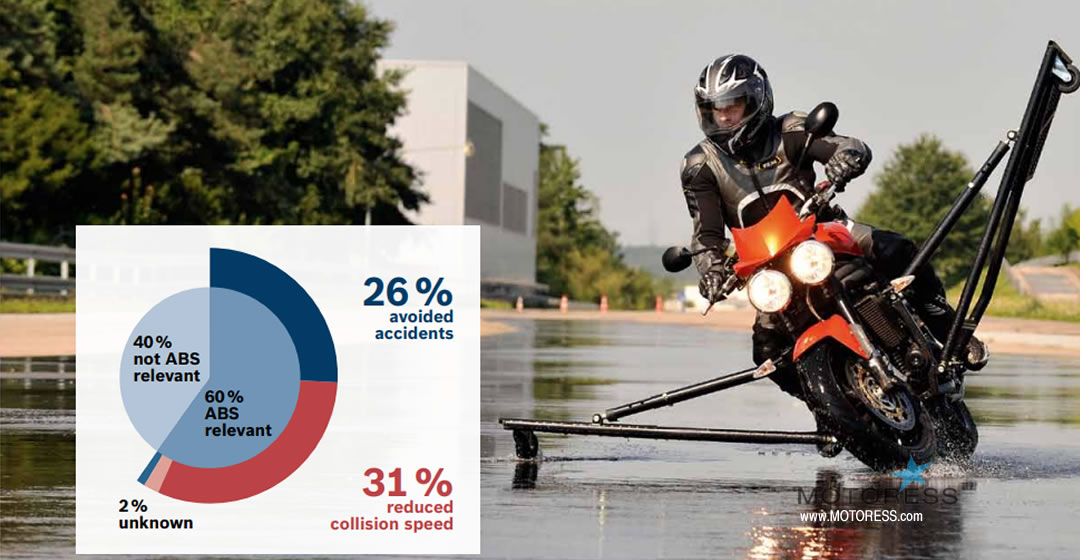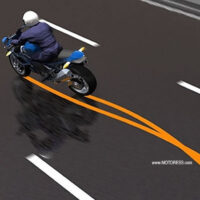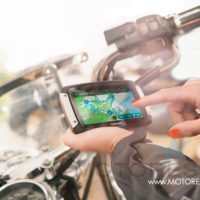Last Update: 9 April 2024

Braking with ABS, Anti-Lock Braking Systems on your motorcycle not only enhances safety but also offers a satisfying and rewarding experience for every rider. Anti-lock brakes live up to their name by effectively preventing brake lock-ups, thereby averting skids and loss of grip. In today’s motorcycle landscape, ABS has become an essential feature, if not a standard, for every road rider, ensuring heightened control and confidence in varying road conditions.
Motorcycle ABS significantly reduces stopping distance, a fact substantiated by the Austrian Safety and Prevention Board’s comprehensive study in 2002. The study revealed that ABS can prevent up to 26% of all motorcycle accidents resulting in injuries, highlighting its pivotal role in enhancing rider safety. Moreover, ABS was found to reduce collision speed by 31% in accidents with injuries, further underscoring its positive impact on motorcycle safety outcomes. These findings underscore the invaluable benefits that ABS technology offers to motorcycle riders, affirming its effectiveness in mitigating risks on the road.
It’s essential to recognise that while utilising the ABS system on your motorcycle enhances braking safety, it doesn’t automatically make you a braking expert. Various factors still influence braking dynamics. Nevertheless, as you become accustomed to ABS, its benefits become increasingly apparent. This technology offers invaluable advantages, providing enhanced security and reliable outcomes during emergency or abrupt stops. The confidence boost it affords riders is immeasurable, making it a worthy investment in safer and more enjoyable riding experiences.
Anti Lock Braking Systems (ABS) can vary in certain circumstances depending on the ABS manufacturer and the type of motorcycle.
Mastering Motorcycle Braking: ABS Tips
Here are some crucial tips for braking with ABS. The golden rule to bear in mind is to consistently employ the correct quick stop braking technique, applying your brakes as you would if your motorcycle didn’t have ABS.
- Begin braking by pressing the rear brake lever while simultaneously pulling in on the front brake lever quickly, but not abruptly. Once the brake pads are engaged, increase the braking pressure quickly, and in significant amounts.
- When performing a full braking manoeuvre remember to always set the bike up straight to ensure use of the full contact patch of your tire(s); brake on straight course within the ABS control range. Depending on the model, you can tell that the ABS has kicked in through a gentle pulsing on the hand and foot brake levers, as well as a “tacking” sound.
- When performing a full braking manoeuvre, always disengage the clutch at the same time.
- When braking in bends, increase the braking pressure gently to prevent the front wheel from slipping to the side.
- Always pay attention to the rear of the motorcycle when performing a full braking manoeuvre. If you feel the rear wheel lift, you then reduce the braking pressure on the front wheel as quickly but smoothly as possible. This does not mean let go of the lever, simply reduce pressure.

Modern ABS systems, such as the generation nine motorcycle ABS systems from Bosch, offer valuable support to riders. These systems include intelligent rear-wheel lift-up control and are specifically engineered to facilitate full-power braking in all emergency situations, particularly when travelling in a straight line.
Preparation is key when it comes to handling emergencies effectively. Therefore, it’s essential to make a habit of braking within the ABS control range during your regular rides. This practice enables you to familiarise yourself with your motorcycle’s anti-lock braking system, allowing you to utilise its full potential should a serious incident occur.
Before delving into real-world scenarios, it’s crucial to hone your skills and familiarise yourself with your motorcycle’s ABS under the guidance of a qualified instructor. This ensures that you’re well-prepared and equipped to handle any challenging situations that may arise on the road.
*Partial source, Bosch





1 comment
Modern ABS Systems control the rear too. Even if the rear wheel is lifting up the system is reducing the breaking pressure in the front to prevent a complete “stoppie” which usually ends in a crash with us once in a while none professional rider.
And since 2013, ABS systems with the capability of doing ABS breaking in curves (leaning in a curve an pulling the break lever) are more an more available at the high end motorcycle from KTM, Honda and BMW.
See the BMW S1000XR at your dealership in end of June, that has the newest set of electronic helper.